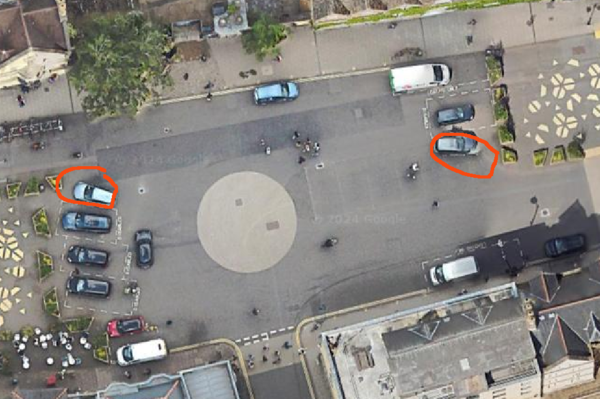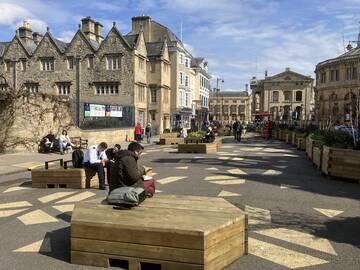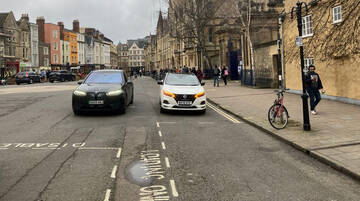The legal changes to Broad St have been made permanent, but the current layout is clearly still temporary, in the sense that many of the features of the area no longer reflect its actual use. Most obviously, most of the existing kerbs are now redundant, or in the wrong place, and serve only as a trip hazard.
A proper plan for Broad St needs to be part of a redesign of the entire area of the city centre north of High St and east of Cornmarket, as envisaged in the Oxford Preservation Trust's proposals twenty years ago, and any such plan will be dependent on funding which is not yet available. But there are possibilities in the management of vehicle access and parking for improvements that could plausibly be implemented in the shorter term.
The entire space should, by default, be for walking and wheeling, or for standing or sitting around in. Among the place-making possibilities that seem most attractive to me are a fountain, some kind of play area, and proper trees. Space should be allocated to transit only as necessary for cycling, delivery and service vehicles, disabled parking, and bus services that can't be relocated.
motor traffic
One can see people on Broad St already trying to use it as a public square, standing around on the carriageway as if it belonged to people rather than to motor traffic. And motor vehicle movements are almost low enough for this to work. With high numbers of people walking, cycling and just standing or sitting around, every car - or motorcycle - movement creates huge negative effects. So a basic goal must be to restrict motor traffic to the minimum necessary.
A single noisy motorcycle traversing Broad St can disturb a thousand people and interrupt a hundred conversations. And mopeds using routes they are banned from intimidate and endanger people walking and cycling. So we need enforcement of the existing regulations on Turl St and at the western end of Broad St. Marginally faster takeaway food deliveries are not a public benefit that can possibly outweigh the negative externalities of motorcycles transiting Broad St.
Many drivers appear confused by the parking situation. Some either think it is ok to park in the bus turning circle or are prepared to chance it. Others appear to be looking for parking and failing. In the short term, better enforcement would limit some of the harms from this. In the medium term, the Broad St area - and indeed the whole city centre - should be made a Restricted Parking Zone, with parking only allowed where explicitly marked. This would also allow the removal of a lot of double yellow lines and signage.

Buses do provide significant public benefits, but the turning circle they require currently dominates the entire space. To reclaim this, the few buses that currently use Broad St (the open-top tourist bus and the ST1 Science Transit shuttle bus, perhaps eight buses an hour in peak) could either terminate elsewhere (perhaps using Holywell and Mansfield to turn) or perhaps be allowed to go one-way at low speed (as on Queen St) through the western end of Broad St.
Access for deliveries and services is essential. This needs to be part of a coherent city centre system, ideally with a one-way routing system used to avoid reversing and turning movements and reduce the space required, and with time restrictions keeping motor traffic away during the during peak times for people using the space or commuting through it. The pedestrianised centres in other cities, both in the UK and overseas, manage with restricted hours for deliveries. Vehicles serving the Covered Market could perhaps enter via Turl St and exit via Cornmarket (or vice versa). HGVs might need to reverse into Turl St to get back out of Broad St - that is rare and they could be required to have someone banking them.
Ultimately this area - and indeed the entire city centre - needs to be "access only if permitted" for motor vehicles, with pre-booking required and ANPR camera enforcement.
cycling
With 5,000 cycle movements a day at its eastern end, Broad St is a key east-west cycle route, indeed in many cases the only practical one (Brasenose Lane is too narrow and Radcliffe Square is cobbled, High St has too many buses and taxis to be generally accessible, and Lamb and Flag Passage is hardly suitable for any volume of cycle traffic). The best provision for this would be a 4m wide two-way cycle track, bifurcating to connect the three Broad St entries.
These tracks need to be clearly marked, with cycle symbols, a distinctive colouring consistent with cycling provision elsewhere, and an edging that is detectable by the visually impaired but not a trip hazard (and which can be safely and easily walked or cycled over). Pedestrians should be free to cross this track anywhere, but it would give them guidance not to linger on it. Similarly, to encourage people cycling to stay on the cycle tracks, they should follow desire lines and be surfaced to be smoother and more comfortable to cycle on than the rest of the space.
(The alternative would be a single surface with no separation between walking and cycling. I believe that cycling volumes are high enough to make this significantly less attractive both for pedestrians and for people cycling.)
These cycle tracks would also be used by motor vehicles for loading and deliveries, and possibly by low-frequency low-speed buses, if these can be routed along a one-way system (otherwise significantly more width will be required to accommodate two-way motor traffic). But they would be clearly designed and presented as cycle tracks — on which motor vehicles would be temporary guests — and not as roads.
This could be trialled with cheap "paint only" tracks, to get the alignments right before a more substantial rebuild.
I would like to see Broad St as part of a connected and coherent east-west route through the city centre.



This is a really well thought out and comprehensive consideration of the current messy and unsuccessful partial pedestrianisation of Broad st.
The bus turning circle does ridiculously and disproportionately take up too much space but if they exited @ the W end wouldn’t they risk conflict with buses turning out of Magdalen St E ? They are also of course another hazard for both cyclists and pedestrians navigating around locking up bikes and walking outside Waterstones….
A dedicated cycle track along Broad st would be so good and during the horrible Xmas market sh-show cyclists shld not be forced into a tunnel speed track which just becomes dangerous for everyone!
And definitely, definitely those scooters and illegal electric delivery ‘bikes’ need banning or minimally and clearly re-directed!
Keep on pursuing this to make Broad st a more attractive and communally functioning city centre street.
Thank you